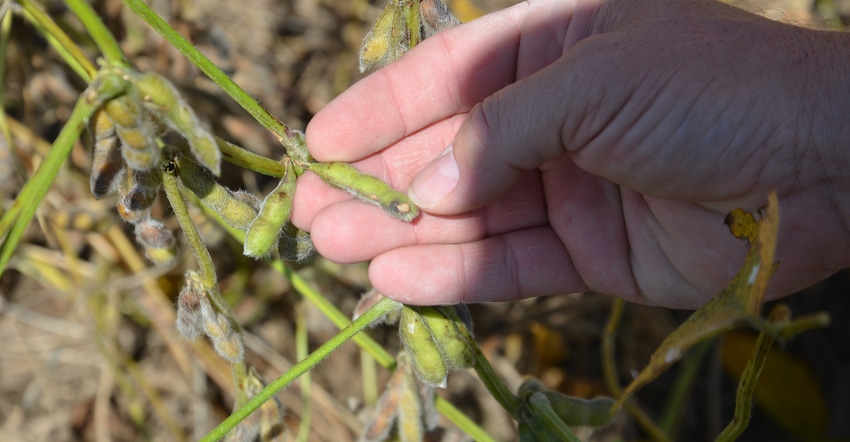
Early reports on soybean harvest in Indiana read like a tale of two cities. One farmer in southern Indiana sent a photo of ugly soybeans with inconsistent size and shape and some purpling, and noted that most loads arriving at a local elevator in early September looked like those in the picture. Yet a farmer in northern Indiana looked surprised when someone asked if he was seeing damaged soybeans and quality issues. He was harvesting good yields with big beans and little damage.
Steve Gauck isn’t surprised that there are issues with grain quality in soybeans in certain areas of Indiana. He’s a Beck’s sales agronomist based in Greensburg, Ind., and has scouted the Soybean Watch ’18 field on a regular basis all season. The field is in south-central Indiana. Beck’s sponsors Soybean Watch ’18.
Overall, it’s a good field of soybeans, Gauck says. There are three varieties in the field, which complicates trying to estimate yield, but soybean yields are always hard to estimate, he adds. He expects above-average yields, with perhaps some impact from areas within the field that were too wet during parts of June. The field is not well-tiled and includes a sizable amount of somewhat poorly drained soils.
Quality concerns
What Gauck noticed on his last visit to the Soybean Watch ’18 field in early September explains why he’s not surprised that some seed and grain quality issues are surfacing. Reports from customers elsewhere, especially in southern Indiana, add to his expectations.
“We saw a considerable number of stinkbugs on that last scouting trip,” he notes. They included green adult, brown adult and nymph-stage stinkbugs. Where there were stinkbugs, there was evidence of chewing on pods.
Pods with scarring on the outside usually showed some sort of damage on the inside when opened, Gauck says. In some cases, seeds were smaller than you would expect. In other cases, they were shriveled. Secondary molds or infections were underway in some cases.
Stinkbugs aren’t the only insect that can cause pod damage and impact both bean size and quality. John Obermeyer and Christian Krupke, Purdue University Extension entomologists, recently noted in the Purdue Pest & Crop Newsletter that they were receiving reports of pod feeding, and even getting samples to examine from some fields where insects had been at work.
Both Extension specialists said bean leaf beetles can also feed on pods before harvest. They can produce similar results inside the pod to what happens if stinkbugs feed on pods.
In fact, they’ve found pods this year where it appears that both stinkbugs and bean leaf beetles attacked the same pod. The result was not good for the beans inside. Typically, every bean in those pods was damaged in one way or the other.
Gauck adds, however, that just because he found stinkbugs in the Soybean Watch ’18 field doesn’t mean there will be a huge quality issue. The condition didn’t seem to be widespread, even on plants where some pods were damaged.
“We’ll have to wait until the combine runs and see just how much of an issue it is here,” he concludes.
About the Author(s)
You May Also Like




